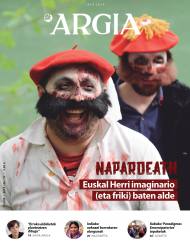If it's an outburst
- “I’ve done a Hitan course”; “Well, I’m going to start myself right now”; “I’ve heard him say that they’ve also organized it in their people.” These kinds of conversations are heard in both of them, always in Gipuzkoa. Have the courses multiplied more than ever? Who will be the student? Is the Hitman a little sad? Without wishing to do an exhaustive study, thanks to three Hitan teachers, we have put the thermometer. Xabier Eizagirre Landa, Ritxi Lizartza Urrestarazu and Iñaki Iturain Azpiroz have accompanied us.

We will start with the question that we have ended with the three teachers. Is the Hitman a little sad? Or, rather, are Hitan's courses in heat? Xabier Eizagirre has been a professor of Iral since 1981-82. Give Hitan classes to professors who are going to improve Euskera. He has also taught courses outside Irale, in the neighbourhoods of Amara and Egia of Donostia-San Sebastián, and in Oiartzun. The sensations of Eizagirre have two tastes: “Yes, something moves; Zumaia, Azpeitia, Tolosa, Oñati, Zestoa... Always in Gipuzkoa. When we make the offer of Hitan schools in Irale, I've realized that there are more people than before it's pointed. Outside Irale, some association organizes the course and people respond. Often poison! On the other hand, you mentioned the difficulty and I will use the term bloom. I don't know if it's the tree or the plant that's giving the last kicks, the last bunch of flowers. New flowers may emerge, which has happened in Bertsolaris, but we are far from humility. The courses that are now being developed are a small hope. In any case, to move forward, priority must be given to noka, that girls learn, but boys too”.
Iñaki Iturain is the coordinator of the Centers for Idiomatic Entrenchment in the Department of Education of the Basque Government, Euskera Service. In addition to this work, he taught Hitano courses in Donostia-San Sebastián, Orio and Zarautz. The organizers have been associations of Euskera, municipal Euskaltegis and municipalities. He doesn't think we're in trouble, in some places he's barely noticed some attempts: “But they are insignificant. In a systematic and serious way, nothing is done to allow children to learn, neither in the public school, nor in the ikastolas, nor in the Euskaltegis. The hika is surviving tradition and transmission, but the loss is very considerable. Noka is being lost everywhere and among the youngest the phenomenon of ‘abuse’ has spread [even when no Hitan forms are needed]. If the Department of Education, the Ikastolas Federation and Linguistic Policy do not take serious decisions, we are talking about a ship that will sink within a few generations. Symbolically, a few things are being done, Zakilixut, the serious effort of several people (Kike Amonarriz, Ritxi Lizartza, Juan Martin Elexpuru..), also from feminism, but it is not enough.
Ritxi Lizartza: "Taking into account the gender perspective [above all they want to deal with the loss of noka], the collectives who want to work the Hitan are raising demands and it is important to activate collectives who were unaware of the first Hitan".
In 2009, Ritxi Lizartza published the manual to learn how to make Hika: Hitano. Talk, buddy! (Maramara). In recent years it has given many classes of Hitano, especially in public institutions, but also at the request of the Basque associations. He has had students, above all, teachers of education and schools of Euskaldunization. We have also asked him about galantry: “If the courses are not organized, nobody else will ask for them, but if they are done, the word of mouth influences them. In 2009, I pulled out the manual, and between 2012, I noticed a wave of requests. I don't know if you're one of those buzzing courses. After 2012 there was a stop and they have now been re-applied. From the gender point of view [above all they want to deal with the loss of the noka] the collectives who want to work the Hitan are demanding and it is important to activate collectives who were not aware of what the first Hitan was. However, I understand that women’s empowerment is important, but men must also be attracted to swimming. In any case, the path that has been opened is very important. This will strengthen the tendency to teach courses and awareness as well. I’d like to move on.”
Who is the Hitan student?
We can ask the three teachers what the students are like and describe their profile more or less. We've been told who doesn't go to Hitano's courses -- young people. Always talking about places where Hitano is alive, young people do it on the street, much and badly. They have a poor knowledge of the Hitan and are not aware that they are using it badly. Those who are going to receive classes are more mature and there are many intentions. Some students have started from scratch. They have learned Basque in the Basque Country, many have come to EGA and want to continue working the language. The Hitman intrigues them. Many other students approach the classes with the intention of improving the tutorial. Some just use it in their day-to-day lives, but they've heard it on the street, at home, between friends and friends. Others are biting, but they realize they're wrong. They speak by putting the Hitan forms where they are not needed, Eizagirre calls it “hika ez, erdika”, and Iturain mentioned “excess”. Iturain, for example, had as students the bertsolaris Orion, with the intention of improving the Hitan. The other big mistake is hitting women instead of noka, a widespread failure. Men who say they don't know noka go to school. In fact, there are several hika speakers who think they're in a straight line with women and don't realize that women are playing.
Xabier Eizagirre: -You mentioned the biscuit and I will use the term flowering. I don't know if it's the tree or the plant that gives the last kicks, the last bunch of flowers.
As for gender, it seems that students are somewhat more numerous. However, the three teachers have met groups of all kinds, some of them from both, but they have also met the group of one woman and the group of one man. Regarding female students, Lizartza clarifies that although students have sometimes approached concerned about the loss of noka, most women have participated in the courses for the question and the misuse of Hitano.
Little of humiliation, therefore. Maybe the last Mohicans trying to be better hika speakers and curiosity.
Hamahiru ZirHika kide batu dira hitanoaren erabilera aldarrikatzeko eta antolakundearen ekintzen berri emateko. Azalpenak Badihardugu elkarteko Idoia Etxeberria eta Galtzaundiko Uxoa Elustondok egin dituzte. Horiei, Andoni Egaña eta Amaia Agirre bertsolariak eta... [+]
When we talk about Hika or Hitano, or rather the ‘correct’ use of Hitano, because from time to time there is a little debate – whether on social networks or in what we still call real life – if we do not want to write some lines here too. What's the key? For what would be... [+]
“Xaukena xauk!” esaten omen dute oñatiar gazteek “besterik ez zegok!” adierazteko. Boladan jarri omen da esaera. Hikako forma horren erabilera, ordea, ez da hitanoaren osasun onaren adibide. Mutilek hala moduz darabilte toka, “xaukena... [+]























